sensor VOLVO XC90 2003 User Guide
[x] Cancel search | Manufacturer: VOLVO, Model Year: 2003, Model line: XC90, Model: VOLVO XC90 2003Pages: 242, PDF Size: 6.5 MB
Page 50 of 242
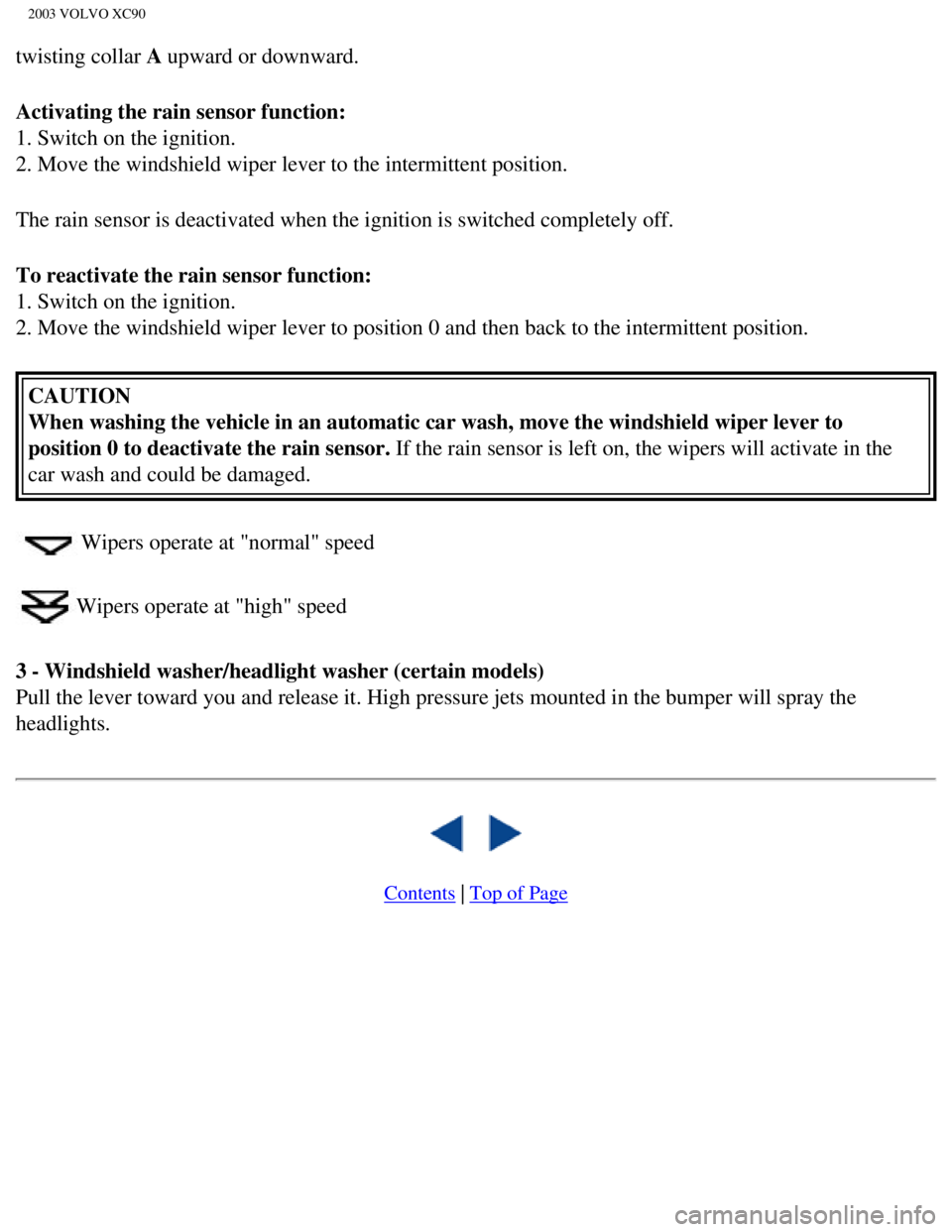
2003 VOLVO XC90
twisting collar A upward or downward.
Activating the rain sensor function:
1. Switch on the ignition.
2. Move the windshield wiper lever to the intermittent position.
The rain sensor is deactivated when the ignition is switched completely \
off.
To reactivate the rain sensor function:
1. Switch on the ignition.
2. Move the windshield wiper lever to position 0 and then back to the in\
termittent position. CAUTION
When washing the vehicle in an automatic car wash, move the windshield w\
iper lever to
position 0 to deactivate the rain sensor. If the rain sensor is left on, the wipers will activate in the
car wash and could be damaged.
Wipers operate at "normal" speed
Wipers operate at "high" speed
3 - Windshield washer/headlight washer (certain models)
Pull the lever toward you and release it. High pressure jets mounted in \
the bumper will spray the
headlights.
Contents | Top of Page
file:///K|/ownersdocs/2003/2003_XC90/03xc90_02a.htm (16 of 16)12/30/20\
06 4:18:52 PM
Page 65 of 242

2003 VOLVO XC90
2 0 0 3
VOLVO XC90
Climate control
pg. 45 Climate control
Climate control system-general information46
Air distribution47
Electronic Climate Control (ECC)48
pg. 46 Climate control
Climate control system-general information
Condensation on the inside of the windows
Keeping the insides of the windows clean will help reduce the amount of \
condensation that forms on the windows. Use a
commercial window cleaning agent to clean the windows.
Ice and snow
Always keep the air intake grille at the base of the windshield free of \
snow.
Cabin air filter
Replace the cabin air filter with a new one at intervals shown in your W\
arranty and Service Records Information booklet.
The filter should be replaced more often when driving under dirty and du\
sty conditions. The filter cannot be cleaned and
therefore should always be replaced with a new one.
Sensors
The sunlight sensor on the dashboard and passenger compartment temperatu\
re sensor in the ECC control panel should not
be covered in any way as this could cause incorrect information to be se\
nt to the ECC system.
Parking the vehicle in warm weather
If your vehicle has been parked in the sun in warm weather, opening the \
windows and moonroof (option) for several
minutes before driving will help release the warm air from the passenger\
compartment. When the engine is running, close
the windows and moonroof and use the recirculation function for several \
minutes to enable the air conditioning to cool the
compartment as quickly as possible.
Windows and optional moonroof
The ECC system will function best if the windows and optional moonroof a\
re closed. If you drive with the moonroof open,
we recommend that you manually adjust the temperature and blower control\
(the LED in the AUTO switch should be off).
file:///K|/ownersdocs/2003/2003_XC90/03xc90_03.htm (1 of 7)12/30/2006 \
4:18:54 PM
Page 70 of 242

2003 VOLVO XC90
A/C - ON/OFF
Press the switch to turn the air conditioning on or off. The "ON" or "OF\
F" LED will light up to indicate if the system is
switched on or off. Other functions will still be regulated automaticall\
y (if the AUTO switch is on).
l The air conditioning functions only at temperatures above 32° F (0°\
C).
l While the Defroster function is selected, the air conditioning is tempor\
arily activated to dehumidify the air, even if you
have manually switched the air conditioning off. This will only function\
if the blower is not switched off.
Recirculation
Press this switch to engage the recirculation function (air in the pass\
enger compartment recirculates - no fresh air enters the
compartment). The LED in the switch will light up to indicate that the \
function is engaged.
l Use this function if the outside air is contaminated with exhaust gases,\
smoke, etc or to heat/cool the vehicle quickly.
l Recirculation should not be used for more than 15 minutes. If your windows begin to fog or mist, make sure that the
recirculation function is switched off.
l Selecting Defroster automatically switches recirculation off.
l Timer mode activation: (Vehicles equipped with the Interior Air Quality System have no timer m\
ode) Press and hold
the recirculation button for at least 3 seconds to activate a recirculat\
ion timer mode. The amber LED in the recirculation
button will flash 5 times to show that the timer mode is being activated\
. In timer mode, each time the recirculation button is
pressed, the climate control system will recirculate the air in the pass\
enger compartment for 5-12 minutes, depending on the
outside air temperature, and then revert back to fresh air.
l Timer mode deactivation: Press and hold the recirculation button for 3 s\
econds. The amber LED in the recirculation
button will illuminate steadily for 5 seconds to show a return to "norma\
l" mode.
pg. 51 Climate control
l In normal mode, when the recirculation button is pressed, the climate co\
ntrol system will recirculate the air in the
passenger compartment until the recirculation button is pressed again.
l Timer mode memory: If the vehicle is turned off while timer mode is acti\
ve, timer mode will still be active when the
vehicle is restarted.
Interior Air Quality sensor (option)
Some vehicles are equipped with a multifilter and Air Quality sensor. Th\
e filter separates gases and particles, thereby
reducing the amounts of odors and contaminants entering the vehicle. The\
Air Quality sensor detects increased levels of
contaminants in the outside air. When the Air Quality sensor detects con\
taminated outside air, the air intake closes and the
air inside the passenger compartment is recirculated, i.e. no outside ai\
r enters the vehicle. The filter also cleans recirculated
passenger compartment air. When the ECC system is in the AUTO mode, the \
green LED will be on
.
file:///K|/ownersdocs/2003/2003_XC90/03xc90_03.htm (6 of 7)12/30/2006 \
4:18:54 PM
Page 71 of 242
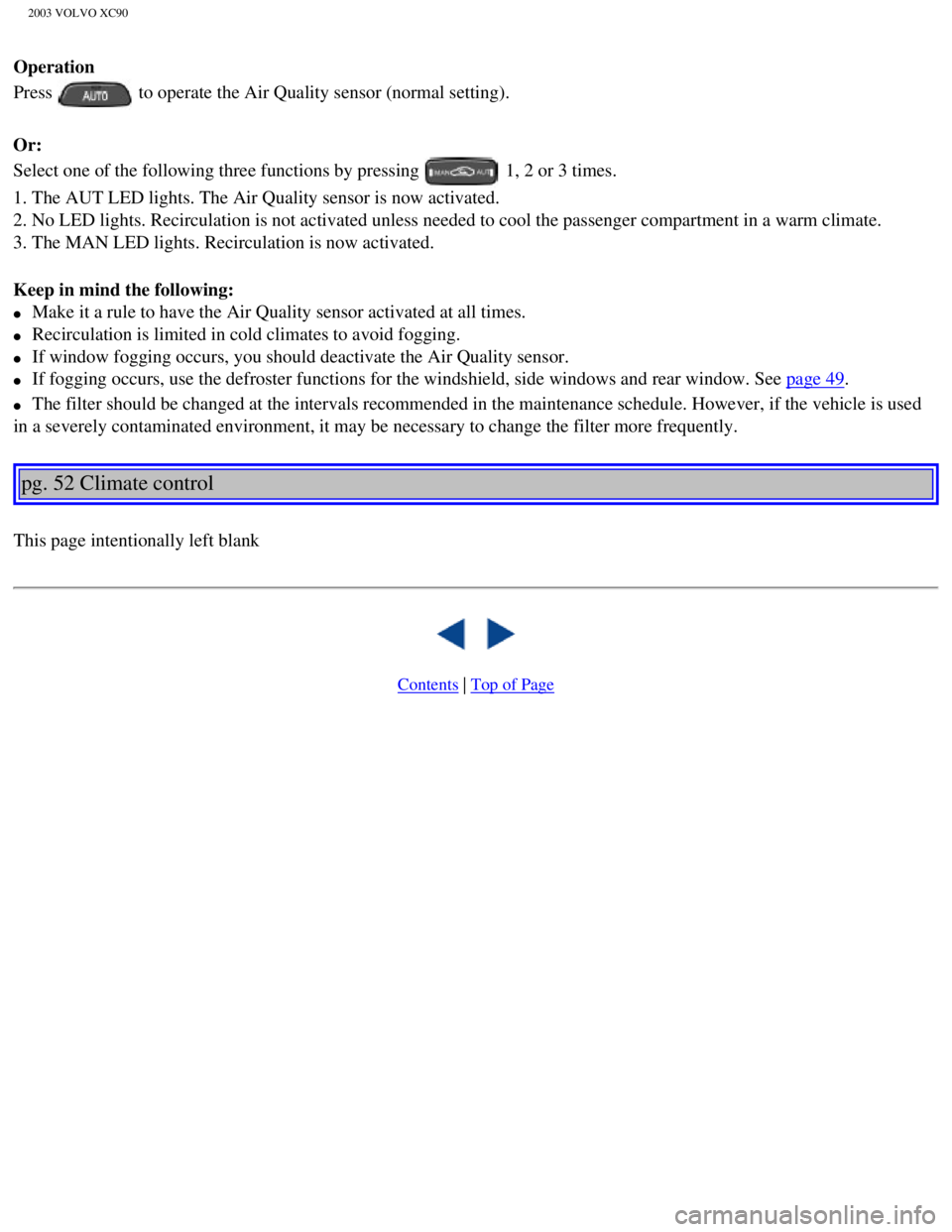
2003 VOLVO XC90
Operation
Press
to operate the Air Quality sensor (normal setting).
Or:
Select one of the following three functions by pressing
1, 2 or 3 times.
1. The AUT LED lights. The Air Quality sensor is now activated.
2. No LED lights. Recirculation is not activated unless needed to cool t\
he passenger compartment in a warm climate.
3. The MAN LED lights. Recirculation is now activated.
Keep in mind the following:
l Make it a rule to have the Air Quality sensor activated at all times.
l Recirculation is limited in cold climates to avoid fogging.
l If window fogging occurs, you should deactivate the Air Quality sensor. \
l If fogging occurs, use the defroster functions for the windshield, side \
windows and rear window. See page 49.
l The filter should be changed at the intervals recommended in the mainten\
ance schedule. However, if the vehicle is used
in a severely contaminated environment, it may be necessary to change th\
e filter more frequently.
pg. 52 Climate control
This page intentionally left blank
Contents | Top of Page
file:///K|/ownersdocs/2003/2003_XC90/03xc90_03.htm (7 of 7)12/30/2006 \
4:18:54 PM
Page 97 of 242
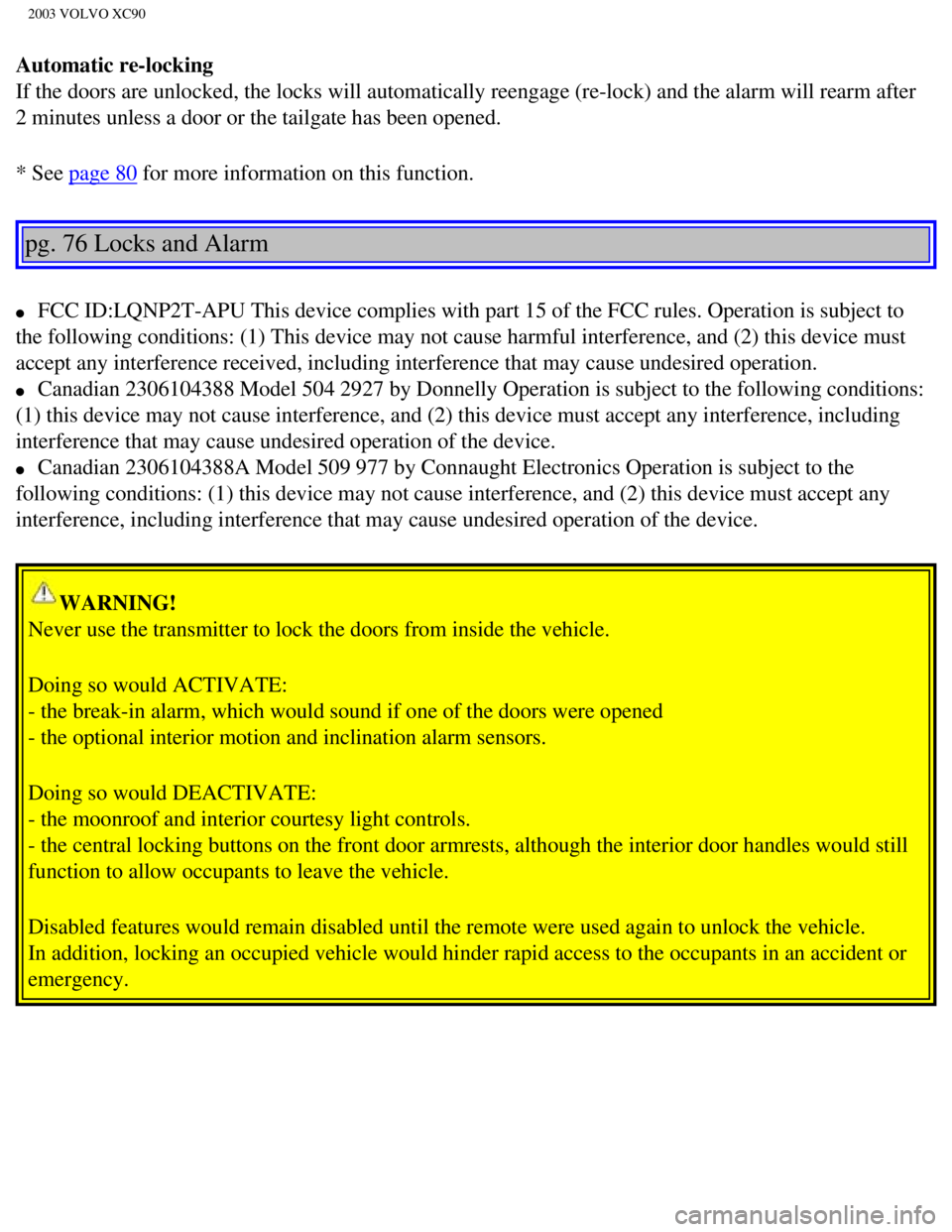
2003 VOLVO XC90
Automatic re-locking
If the doors are unlocked, the locks will automatically reengage (re-lo\
ck) and the alarm will rearm after
2 minutes unless a door or the tailgate has been opened.
* See
page 80 for more information on this function.
pg. 76 Locks and Alarm
l FCC ID:LQNP2T-APU This device complies with part 15 of the FCC rules. Op\
eration is subject to
the following conditions: (1) This device may not cause harmful interf\
erence, and (2) this device must
accept any interference received, including interference that may cause \
undesired operation.
l Canadian 2306104388 Model 504 2927 by Donnelly Operation is subject to t\
he following conditions:
(1) this device may not cause interference, and (2) this device must\
accept any interference, including
interference that may cause undesired operation of the device.
l Canadian 2306104388A Model 509 977 by Connaught Electronics Operation is\
subject to the
following conditions: (1) this device may not cause interference, and \
(2) this device must accept any
interference, including interference that may cause undesired operation \
of the device.
WARNING!
Never use the transmitter to lock the doors from inside the vehicle.
Doing so would ACTIVATE:
- the break-in alarm, which would sound if one of the doors were opened \
- the optional interior motion and inclination alarm sensors.
Doing so would DEACTIVATE:
- the moonroof and interior courtesy light controls.
- the central locking buttons on the front door armrests, although the i\
nterior door handles would still
function to allow occupants to leave the vehicle.
Disabled features would remain disabled until the remote were used again\
to unlock the vehicle.
In addition, locking an occupied vehicle would hinder rapid access to th\
e occupants in an accident or
emergency.
file:///K|/ownersdocs/2003/2003_XC90/03xc90_05.htm (5 of 11)12/30/2006\
4:18:56 PM
Page 101 of 242

2003 VOLVO XC90
Alarm
Alarm
The alarm is automatically armed whenever you lock your vehicle.
When armed, the alarm continuously monitors a number of points on the ve\
hicle. The following
conditions will set off the alarm:
l The hood is forced open.
l The tailgate is forced open.
l A door is forced open.
l The ignition switch is tampered with.
l If there is movement in the passenger compartment (if the vehicle is eq\
uipped with the optional
movement sensor).
l The vehicle is lifted or towed (if the vehicle is equipped with the opt\
ional inclination sensor).
l The battery is disconnected (while the alarm is armed).
l The siren is disconnected when the alarm is disarmed.
Arming the alarm
Press the LOCK button on the remote control, lock the vehicle using the \
key in the driver's door or press
the central lock button on one of the front doors with the door open. On\
e long flash of the turn signals
will confirm that the alarm is armed.
Disarming the alarm
Press the UNLOCK button on the remote control or unlock the doors with t\
he key.
Turning off (stopping) the alarm
If the alarm is sounding, it can be stopped by pressing the UNLOCK butto\
n on the remote control or by
unlocking the driver's door with the key.
Audible/visual alarm signal
An audible alarm signal is given by a battery powered siren. The alarm c\
ycle lasts for 25 seconds.
The visual alarm signal is given by flashing all turn signals and turnin\
g on the interior lighting for
approximately 5 minutes.
"Panic" button
In an emergency situation, this feature can be used to attract attention\
.
Activate the "panic" button by pressing the red button on the remote con\
trol (see illustration on
page 75)
for at least 3 seconds or by pressing this button twice within 3 seconds\
. The turn signals will flash, the
interior lights will go on and the vehicle's horn will sound.
file:///K|/ownersdocs/2003/2003_XC90/03xc90_05.htm (9 of 11)12/30/2006\
4:18:56 PM
Page 102 of 242
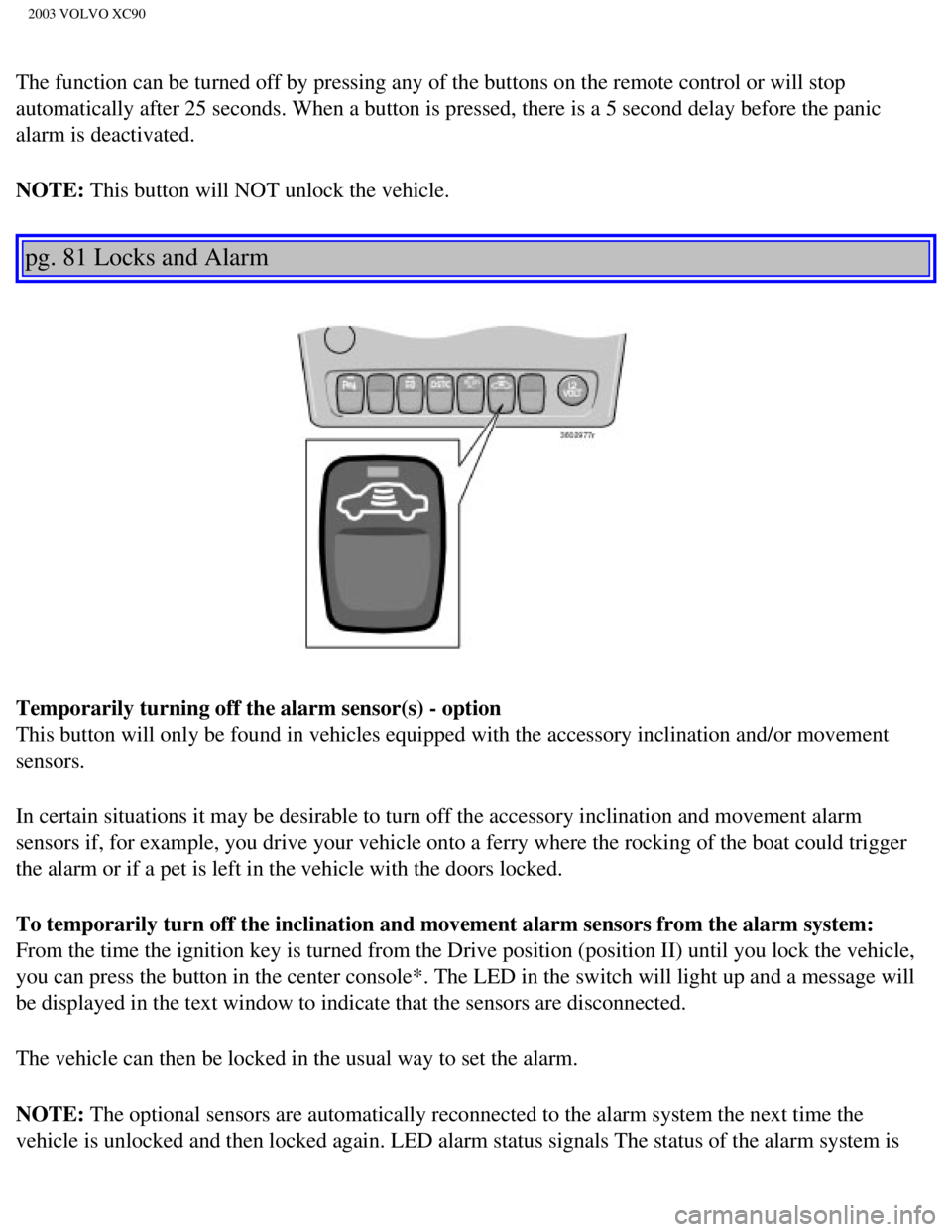
2003 VOLVO XC90
The function can be turned off by pressing any of the buttons on the rem\
ote control or will stop
automatically after 25 seconds. When a button is pressed, there is a 5 s\
econd delay before the panic
alarm is deactivated.
NOTE: This button will NOT unlock the vehicle.
pg. 81 Locks and Alarm
Temporarily turning off the alarm sensor(s) - option
This button will only be found in vehicles equipped with the accessory i\
nclination and/or movement
sensors.
In certain situations it may be desirable to turn off the accessory incl\
ination and movement alarm
sensors if, for example, you drive your vehicle onto a ferry where the r\
ocking of the boat could trigger
the alarm or if a pet is left in the vehicle with the doors locked.
To temporarily turn off the inclination and movement alarm sensors from \
the alarm system:
From the time the ignition key is turned from the Drive position (posit\
ion II) until you lock the vehicle,
you can press the button in the center console*. The LED in the switch w\
ill light up and a message will
be displayed in the text window to indicate that the sensors are disconn\
ected.
The vehicle can then be locked in the usual way to set the alarm.
NOTE: The optional sensors are automatically reconnected to the alarm system t\
he next time the
vehicle is unlocked and then locked again. LED alarm status signals The \
status of the alarm system is
file:///K|/ownersdocs/2003/2003_XC90/03xc90_05.htm (10 of 11)12/30/200\
6 4:18:56 PM
Page 105 of 242

2003 VOLVO XC90
pg. 84 Starting and driving
ENGINE OIL
Although some oil consumption occurs during normal engine operation, mor\
e oil is consumed when the
engine is new as the internal parts generate higher friction while weari\
ng-in to each other. From the time
the engine is new until the first maintenance is performed, the oil cons\
umption could be higher than
normal. For this reason, it is especially important to check the oil eve\
ry time you refuel your vehicle
during this period. See
page 130.
Fuel requirements
Octane rating
Volvo engines are designed for optimum performance on unleaded premium g\
asoline with an AKI
octane rating of 91 or above. AKI (ANTI KNOCK INDEX) is an average of \
the Research Octane
Number, RON, and the Motor Octane Number, MON. ((RON + MON)/2). The \
minimum octane
requirement is AKI 87 (RON 91).
Deposit control gasoline (detergent additives)
Volvo recommends the use of detergent gasoline to control engine deposit\
s. Detergent gasoline is
effective in keeping injectors and intake valves clean. Consistent use o\
f deposit control gasolines will
help ensure good driveability and fuel economy. If you are not sure whet\
her the gasoline contains
deposit control additives, check with the service station operator.
NOTE: Volvo does not recommend the use of external fuel injector cleaning syst\
ems.
Unleaded fuel
Each Volvo has a three-way catalytic converter and must use only unleade\
d gasoline. U.S. and Canadian
regulations require that pumps delivering unleaded gasoline be labelled \
"UNLEADED". Only these
pumps have nozzles which fit your vehicle's filler inlet. It is unlawful\
to dispense leaded fuel into a
vehicle labelled "unleaded gasoline only". Leaded gasoline damages the t\
hree-way catalytic converter
and the heated oxygen sensor system. Repeated use of leaded gasoline wil\
l lessen the effectiveness of
the emission control system and could result in loss of emission warrant\
y coverage. State and local
vehicle inspection programs will make detection of misfueling easier, po\
ssibly resulting in emission test
failure for misfueled vehicles.
NOTE: Some U.S. and Canadian gasolines contain an octane enhancing additive ca\
lled methyl-
cyclopentadienyl manganese tricarbonyl (MMT). If such fuels are used, \
your Emission Control System
performance may be affected, and the Check Engine Light (malfunction in\
dicator lamp) located on your
instrument panel may light. If this occurs, please return your vehicle t\
o an authorized Volvo retailer for
maintenance.
Gasoline containing alcohol and ethers
file:///K|/ownersdocs/2003/2003_XC90/03xc90_06a.htm (2 of 15)12/30/200\
6 4:18:58 PM
Page 122 of 242
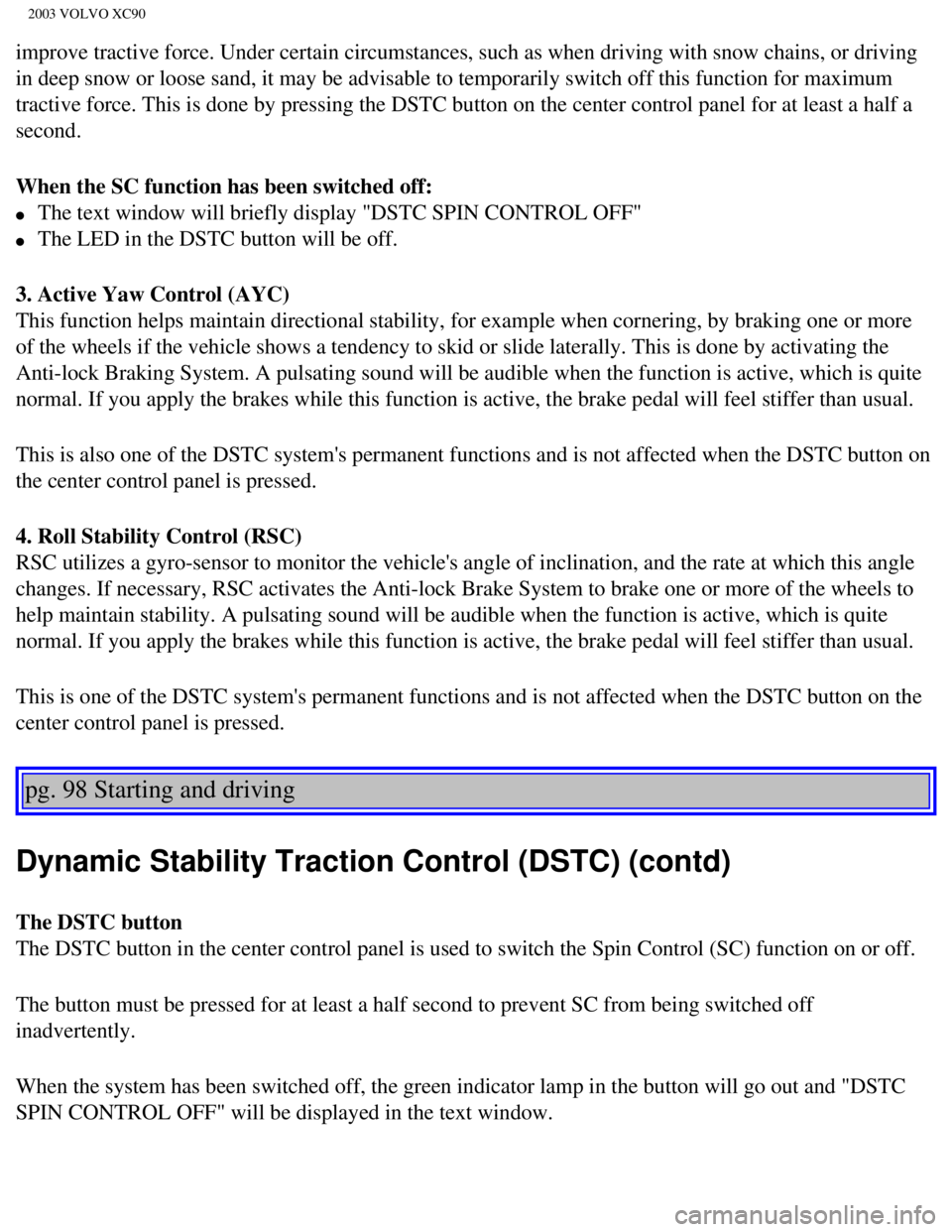
2003 VOLVO XC90
improve tractive force. Under certain circumstances, such as when drivin\
g with snow chains, or driving
in deep snow or loose sand, it may be advisable to temporarily switch of\
f this function for maximum
tractive force. This is done by pressing the DSTC button on the center c\
ontrol panel for at least a half a
second.
When the SC function has been switched off:
l The text window will briefly display "DSTC SPIN CONTROL OFF"
l The LED in the DSTC button will be off.
3. Active Yaw Control (AYC)
This function helps maintain directional stability, for example when cor\
nering, by braking one or more
of the wheels if the vehicle shows a tendency to skid or slide laterally\
. This is done by activating the
Anti-lock Braking System. A pulsating sound will be audible when the fun\
ction is active, which is quite
normal. If you apply the brakes while this function is active, the brake\
pedal will feel stiffer than usual.
This is also one of the DSTC system's permanent functions and is not aff\
ected when the DSTC button on
the center control panel is pressed.
4. Roll Stability Control (RSC)
RSC utilizes a gyro-sensor to monitor the vehicle's angle of inclination\
, and the rate at which this angle
changes. If necessary, RSC activates the Anti-lock Brake System to brake\
one or more of the wheels to
help maintain stability. A pulsating sound will be audible when the func\
tion is active, which is quite
normal. If you apply the brakes while this function is active, the brake\
pedal will feel stiffer than usual.
This is one of the DSTC system's permanent functions and is not affected\
when the DSTC button on the
center control panel is pressed.
pg. 98 Starting and driving
Dynamic Stability Traction Control (DSTC) (contd)
The DSTC button
The DSTC button in the center control panel is used to switch the Spin C\
ontrol (SC) function on or off.
The button must be pressed for at least a half second to prevent SC from\
being switched off
inadvertently.
When the system has been switched off, the green indicator lamp in the b\
utton will go out and "DSTC
SPIN CONTROL OFF" will be displayed in the text window.
file:///K|/ownersdocs/2003/2003_XC90/03xc90_06b.htm (4 of 17)12/30/200\
6 4:18:59 PM
Page 124 of 242
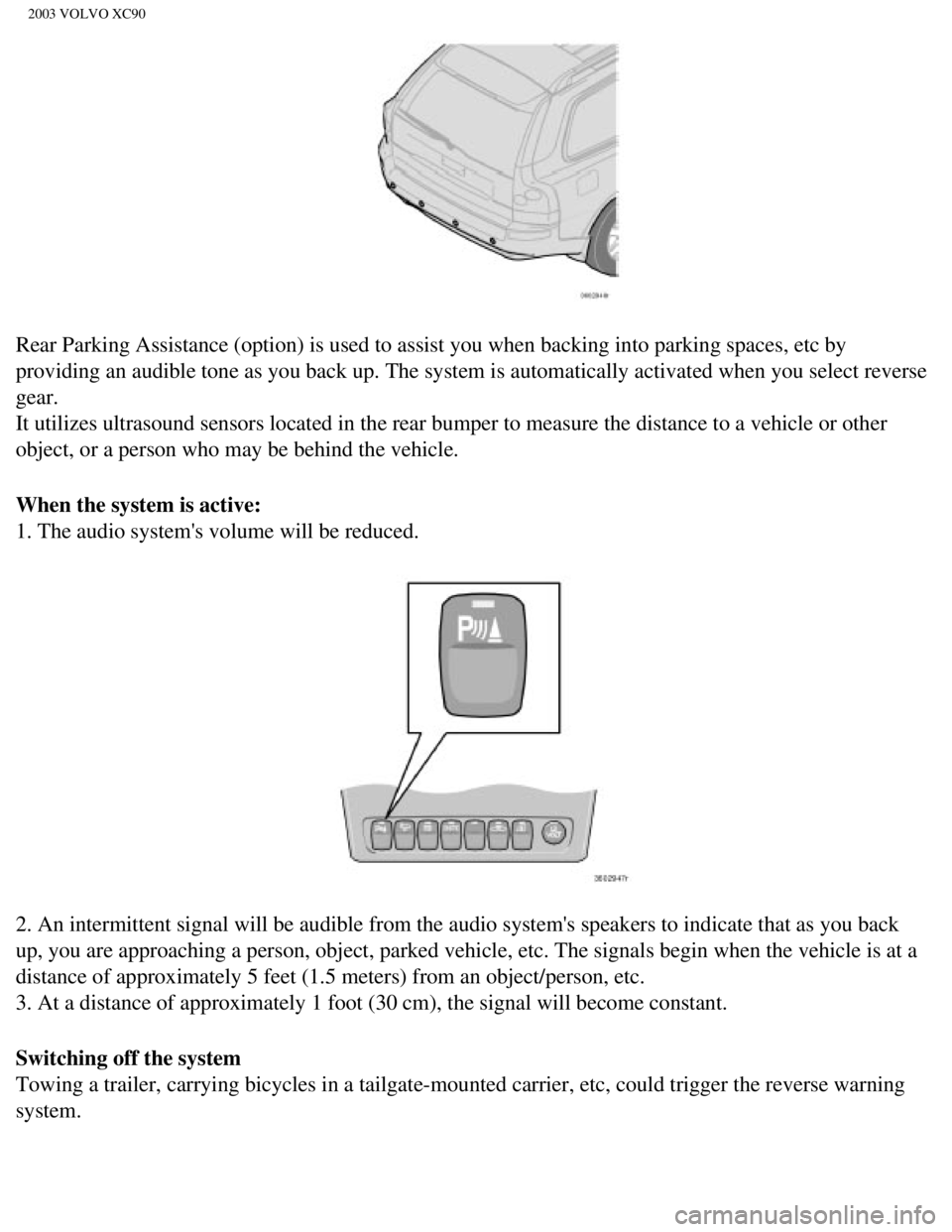
2003 VOLVO XC90
Rear Parking Assistance (option) is used to assist you when backing in\
to parking spaces, etc by
providing an audible tone as you back up. The system is automatically ac\
tivated when you select reverse
gear.
It utilizes ultrasound sensors located in the rear bumper to measure the\
distance to a vehicle or other
object, or a person who may be behind the vehicle.
When the system is active:
1. The audio system's volume will be reduced.
2. An intermittent signal will be audible from the audio system's speake\
rs to indicate that as you back
up, you are approaching a person, object, parked vehicle, etc. The signa\
ls begin when the vehicle is at a
distance of approximately 5 feet (1.5 meters) from an object/person, e\
tc.
3. At a distance of approximately 1 foot (30 cm), the signal will beco\
me constant.
Switching off the system
Towing a trailer, carrying bicycles in a tailgate-mounted carrier, etc, \
could trigger the reverse warning
system.
file:///K|/ownersdocs/2003/2003_XC90/03xc90_06b.htm (6 of 17)12/30/200\
6 4:18:59 PM